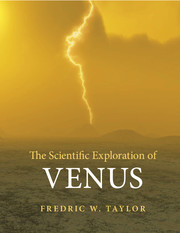Book contents
- Frontmatter
- Contents
- Overview
- Prologue
- A note on scientific units
- Acknowledgements
- Part I Views of Venus, from the beginning to the present day
- Part II The motivation to continue the quest
- Part III Plans and visions for the future
- Epilogue
- References and acknowledgements
- Appendix A Chronology of space missions to Venus
- Appendix B Data about Venus
- Index
- Plate section
Part II - The motivation to continue the quest
Published online by Cambridge University Press: 05 September 2014
- Frontmatter
- Contents
- Overview
- Prologue
- A note on scientific units
- Acknowledgements
- Part I Views of Venus, from the beginning to the present day
- Part II The motivation to continue the quest
- Part III Plans and visions for the future
- Epilogue
- References and acknowledgements
- Appendix A Chronology of space missions to Venus
- Appendix B Data about Venus
- Index
- Plate section
Summary
The motivation to continue the quest
Having arrived at an up-to-date position on missions to Venus, we can now summarise what we know, and ponder what we still wish we knew, about this close-by and Earthlike world. To begin with, as we have seen, in some ways it is not much like the Earth at all, and we seek to find out why.
Since 1962, there have been no fewer than forty-four spacecraft launched towards Venus, to orbit, land, float or just fly past and make observations in transit (although not all of them were successful, see Appendix A). This programme, along with advanced Earth-based observations over a wide range of wavelengths, and some imaginative theory and comparative planetology studies (mostly treating Venus as an analogue of the Earth, recognising that Mars and Mercury are siblings too), has painted a fairly complete general picture of our mysterious neighbour at last.
In some ways, this vision is not too encouraging, at least for those who see planetary exploration as a search for Earthlike, habitable environments. Where Mars turned out to be a cold place with a thin atmosphere, Venus is now seen to be the opposite, with a surface environment far worse, for human survival, than the conditions found in a pressure cooker in any kitchen on Earth. In fact, if a tin of beans was placed on the surface of Venus (and if the tin were really made of tin, which they are not these days) the atmosphere would not only cook the beans but the tin would melt as well. Human expeditions are not therefore on the cards for Venus for quite some time, and the prospects for any kind of life there have faded (but not quite vanished) after centuries of raised expectations based on early twentieth-century predictions of tropical forests and warm, soda-water oceans.
- Type
- Chapter
- Information
- The Scientific Exploration of Venus , pp. 117 - 118Publisher: Cambridge University PressPrint publication year: 2014



